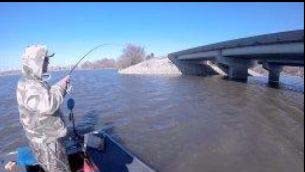Electronics for Winter Crappie Patterns On April 07, 2014
Electronics for Winter Crappie Patterns
by Shane Eustice
Winter crappie fishing in Kansas can be the fastest action most anglers will have all season. A
successful angler needs to know two things: how to find crappie and how to get them to bite.
December through February, Kansas crappie will concentrate on main channel edges, creek and river
channels ledges, roadbeds, or offshore humps. All of these areas can be confusing in a large Kansas
Reservoir. Good electronics allow the angler to easily identify high percentage areas to focus on.
By understanding your electronics and applying a few techniques in this article, you should be able
to produce a good day’s catch.

How do I fish winter patterns in Kansas and take out some of the guess work? Electronics! I use a
Lowrance HDS 12 with StructureScan to find fish on structure or creek channel edges and concentrate
my
efforts on the upper end of the reservoir. Start at a depth of
30 foot or less. A great place to look first is under bridges. Bridges hold crappie more often than
not and usually lots of them. Start at the channel ledge and work your way around the pillars to
search for concentrations of crappie. Baits
should not hit the water until the Lowrance indicates fish are present. If fish are located in
fishable numbers, note the depth of fish and drop a jig to the same depth as the majority of the
fish sonar returns. When a spot like this is found, it can usually produce fish all day long. If
the bite slows down, move around the area and you should find them again. Crappie will move but
they won’t go far!
Kansas water temperatures begin increasing during mid to late March. It is during this transition
period from wintering patterns to spawning patterns that the fish will scatter and StructureScan
becomes a valuable tool for locating the mobile fish. Crappie will scatter throughout trees, mud
flats, rocky areas and brush piles. I drive my boat along the river channel using my StructureScan
to look for shad schools and groups of crappie along tree rows. Most of the
time I won’t find crappie tight to the trees, but they
are around them. In most cases, I find them at the bottom of the water column. Move around trees
and fish about a foot off bottom using a 7’ medium light action rod. Use a heavy ¼ oz. jig and
large baits like a Crappie Pro Wasshoppah Bug. Push the boat forward about .1 to .2 mph to cover
the area. Most of the
time the bite is a very hard strike. You won’t miss many due to the commitment the fish has to take
in order to eat the larger bait.
 Crappie in Trees
Crappie in TreesMudflats and rocks are fished about the same as trees but instead two 1/8 oz. jigs about 18 inches
apart are used. While moving the boat into the wind, let the lower jig hit the bottom and then
raise it up and hold. After a few seconds, allow the jig to drop back to the bottom and repeat the
process. This will usually grab the attention of the crappie that might be laying in the mud or
rocks, triggering a reaction bite. Again, use a 7’ medium action rod and large baits with this
technique. Crappie in mud or rocks can be very hard to see when using electronics, but it can be
done. Keep a look out for any color change or zoom in to get a better read of the bottom.
Brush piles can be fun to catch fish in but can also be very frustrating. Use StructureScan to
locate brush piles along river channels by making long runs
 Crappie in Brush
Crappie in Brushparallel with the channel. When a pile is found, mark it on the HDS 12 and continue the run looking
for others. After a few piles are marked, go back over them with the down scan to get an idea on
how the pile is laid out and how tall it is. Unless you are in deep water, never allow the outboard
motor to run on top of the pile or the fish might spook. Once you have an idea on how the pile
lays, use a 7’ medium action rod with a 1/8 or 1/4oz. jig and large bait. If snags become a problem,
move to a weedless jig and hang‐ups will decrease. Start with the jig on
the bottom about 3 feet away from the pile and move in slowly. Sometime the fish will be around the
pile like they are in trees. If no takers are found outside of the pile, move in closer to the pile
and work the jig around the area. If a crappie commits, repeat the process again. Once the bite
slows down, move to another pile and repeat the process while keeping key information such as
depth, proximity of fish to the pile, and jig action/size/color for use at the next pile. Remember
to revisit previously productive piles as they will reload with fish once disturbance stops.
My Lowrance electronics are the most important tools I use when fishing and guiding for winter time
crappie. If I can’t stay on structure I am fishing, or find big schools of fish under
bridges or in channels, I won’t be very successful. When winter days are shorter and open water can
turn to ice overnight, your time on the water is very important. Learn how to read your electronics
by purchasing Doctor Sonars DVD’s

and your success rate for catching winter time crappie will also
increase. Use your tools to your advantage and have fun. Enjoy your time on the water and remember
important rules for wintertime fishing: Never go alone, wear your PFD, and be safe!
Shane Eustice Doctor Sonar Pro‐Staff
Hook’Em Guide Service www.hookemguide.com

0 Comments







